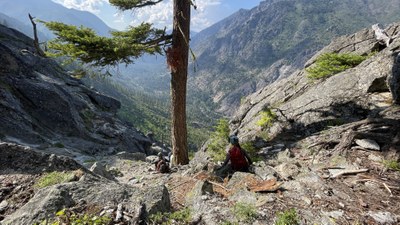
Trip Report
Basic Rock Climb - Yellowjacket Tower/East Flank
As David Johnson said it best: "Yellowjacket Tower is more about managing the ascent and descent of the loose sandy gully than it is about the technical climbing."
- Sat, Jul 8, 2023
- Basic Rock Climb - Yellowjacket Tower/East Flank
- Yellowjacket Tower/East Flank
- Climbing
- Successful
-

- Road suitable for all vehicles
-
The approach to the gully was solid and easy to navigate. The gully itself, aka "nature’s garbage chute" was sandy and full of loose rock. The actual climbing route was solid with good hand and foot holds. I recommend replacing a lot of the rappel tubing along the route as most of it is dated and should be replaced. We did add one or two slings per rap station to give additional strength.
Note: Car to Car with 5 people and six rappels took 12 hours.
I did this as a mentored lead. I did this climb back in 2018 and had some familiarity with the route conditions that we were going to face. With additional research looking at past trip reports, videos I sent out a prep email with the special considerations that we should be mindful of in this climb (ticks, weather, goats and tons of rock fall with mitigation strategies.) Given that we would not encounter any water on the trip and temperatures expected to be in the high 90s it was going to be a day to also be considerate of heat injuries.
Approach
We met at the 76 station at the edge of Leavenworth at 7:00, then drove to the trailhead on Icicle Road https://goo.gl/maps/ALefzjbUUyNd1FNB8 We assigned team roles, refreshed on the plan that I had sent out in the prep email set out. We made good time making it up to the bottom of the gully around 9:00AM. We discussed our options on attacking the scramble into the actual gully, ( go directly up on the path of least resistance , or as another trip report had suggested going wide right then cutting left. We opted to go direct with some solid class 4 moves.
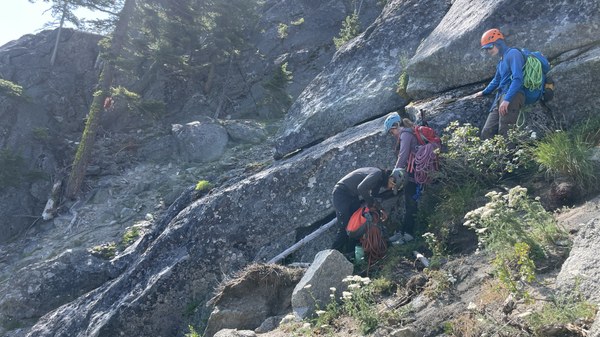 At the point of the above picture the climb leader setup a handline to assist everyone from getting over the final move into the gully itself and to protect exposure. This reduced risk and increased confidence for everyone making over the final move.
At the point of the above picture the climb leader setup a handline to assist everyone from getting over the final move into the gully itself and to protect exposure. This reduced risk and increased confidence for everyone making over the final move.
As you start to ascend the gully, be looking high and to the left and right for big trees (bigger than a person) with lots of rappel tat, make note of those as you'll be rappelling to those trees for your decent. (They were higher than expected)
Continuing up the gully, we found the conditions manageable from a risk perspective, although there was plenty of loose rock that we had to be mindful. We stayed close together as a group and called out any and all loose rocks that we encountered. Are about 2/3 of the way up or so we found the chicken head wall and as other trips had indicated. We started moving toward that direction however in the gully I had spotty GPS signal with two devices that was getting plus or minus 80 meters. This made it appear that we were on track to head right. (In hindsight we ended up moving right about 100 meters sooner than we should have.) A little scramble up some rock and around three trees. I found what I thought was the hidden gully and started moving up until I encountered a bail anchor. At this point I couldn’t continue any higher and it was unsafe for me downclimb. Calling down to the climb leader I advised the situation and I asked him to come to me with a rope so we could lower back down. Due to the quality of the bail anchor, the decision was made to climb higher to another set of bail anchors that appeared to be in better condition and lower from there. Note if you encounter a single webbing with one rap ring, its probably a bail anchor, as real rappel anchors have multiple layers of webbing to back it up. We successfully lowered then the climb leader set up a headline to assist in the scramble down to get back on route. Are everybody now safe and back in the gully proper we ascended the final hundred meters up, time time we found that the chicken head wall was now directly on our right at the 3 o’clock position. The proper hidden looking up into the proper hidden gully was identified and we traversed over to it.
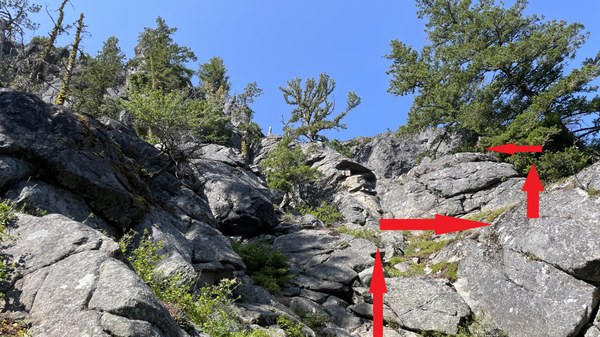
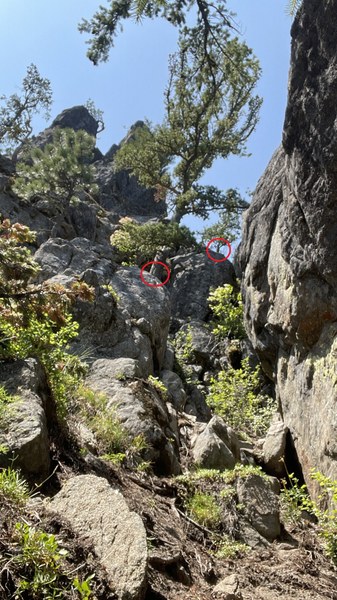
The climb
With everybody now in the hidden gully, I set up a headline up to the start of pitch one connected to the two bolts at the top. As others had indicated to find the much easier move, when you encounter the small chock stone that has a class five move, if you go back 4 feet prior to that and climb up on the right hand side. Having secured the headline and discovering a tick on my hand, we brought everybody up to start the climb.
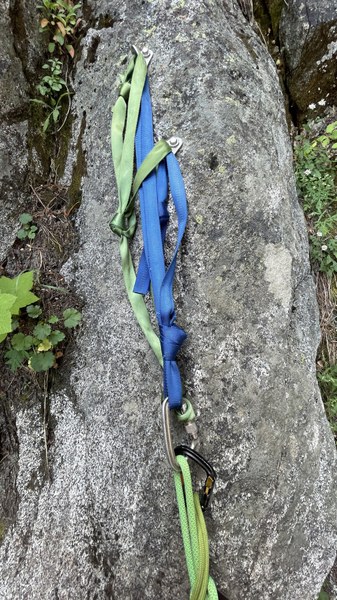
The climb itself was solid. I placed a couple of stoppers in really good positions prior to the crooked tree. I slung the crooked tree, and we found that it’s awfully close from dying and being unusable. Do test this tree out before committing body weight to it. Climbing higher getting to the top of pitch one I found the traditional rappel tree on climbers right has really bad in decayed webbing. 10 out of 10 I wouldnt trust it as it’s all old and all needs to be replaced.
Pitch two was pretty uneventful with the exception of the pocket that the tricam goes definitely does not a pink one. It barely takes a brown one if fit very carefully. I suspect it might take more of a blue try cam. At the top of pitch 2 I had noticed, like the previous trip report had indicated that the anchor anchors freely are spinning. I recommend bringing a wrench to re-tighten both of the bolts. (I had lost mine on the climb itself.) A top rope was setup and everyone had a turn.
Definitely with little shade up top we all felt the 95 degree temperature.
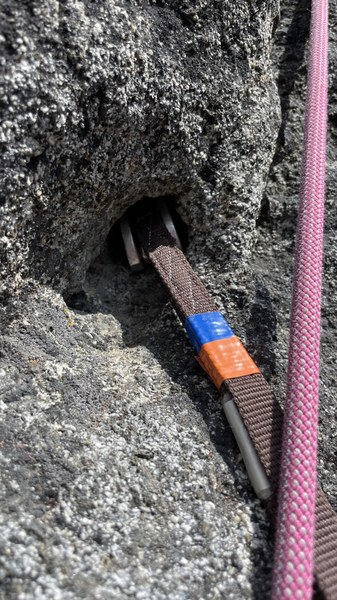
Decent
One looking at the top of pitch 2 there is a solid tree at climbers left. This is the route that we repelled off and we all found it to be one of the most fun repels we’ve ever done. This ends up turning into a hanging rappel that doesn’t happen until about halfway down the descent. A single 60 meter rope from this tree gets you to the bottom of pitch one. Of note pulling the rope was difficult and took two people’s full body weight to pull it down. (Rappel one)
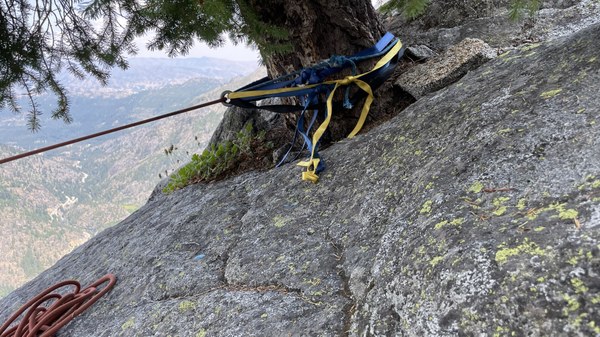
We did a double rope rappel down the hidden gully to get back to our gear and the repel station at the bottom of hidden goalie at the tree. (Rappel two)
A double rope from the tree looking down the gully toward the 2 o’clock position got us to the next rap station at a big tree high on climbers, right. (Rappel three) The climb leader that went down the initial rappel made a point to knock/kick down any loose rocks ahead of time. This way subsequent rappels would knock down less rocks on others.
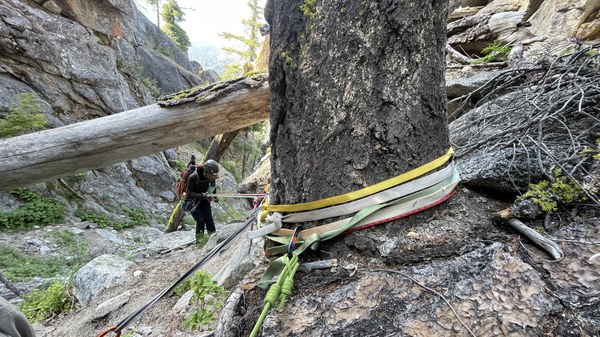
From that tree, another double rappel down the right hand side of the gully takes you to another rap station at a large tree. (Rappel four)
Then another double rope repel get you basically to the top of the gully (Rappel five) with maybe 30 feet of careful walking down towards the final rap station at climbers right. Another double row propel get you off of the gully and back down safely to the approach route (Rappel six.)
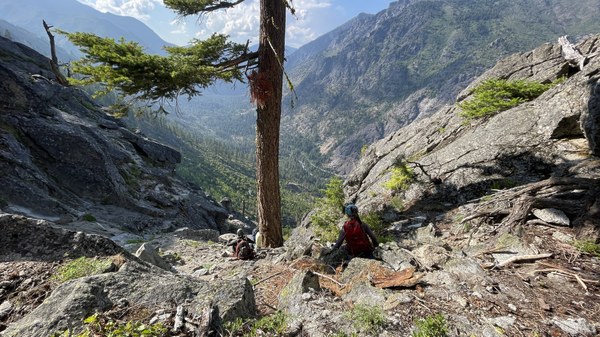
Conditions for the hike down were solid (although dusty) and with GPS aiding us we were able to stay on route.
Back at the cars we all refreshed ourselves by jumping in the creek and celebrated our success.
Conclusion
We all had fun with on this trip, definitely the team you have makes a huge difference in moral and support even during difficult decisions. We had made a mistake getting off route that probably ate up two hours trying to safely navigate the situation. One back on the route everything went smoothly and fun. The climb was the easy part. Yellowjacket is one of those climbs that everyone after the climb says "I'm glad I did, and I hope to never come back." Of course until you forget after 5 years and do come back. Yellowjacket has a lot to offer a leader in terms of risk management, again as David Johnson said it best: "Yellowjacket Tower is more about managing the ascent and descent of the loose sandy gully than it is about the technical climbing." Bring lots of water, I personally ran through 4 liters of water as we started our rappels.
Stay safe out there.
- Prior Mountaineers trip reports
- Video of the climb: https://www.youtube.com/watch?v=0iEM5tuafzQ
- Summit Post: https://www.summitpost.org/yellow-jacket-tower/625569
- Peakbagger: https://www.peakbagger.com/peak.aspx?pid=26048
 Don Sarver
Don Sarver